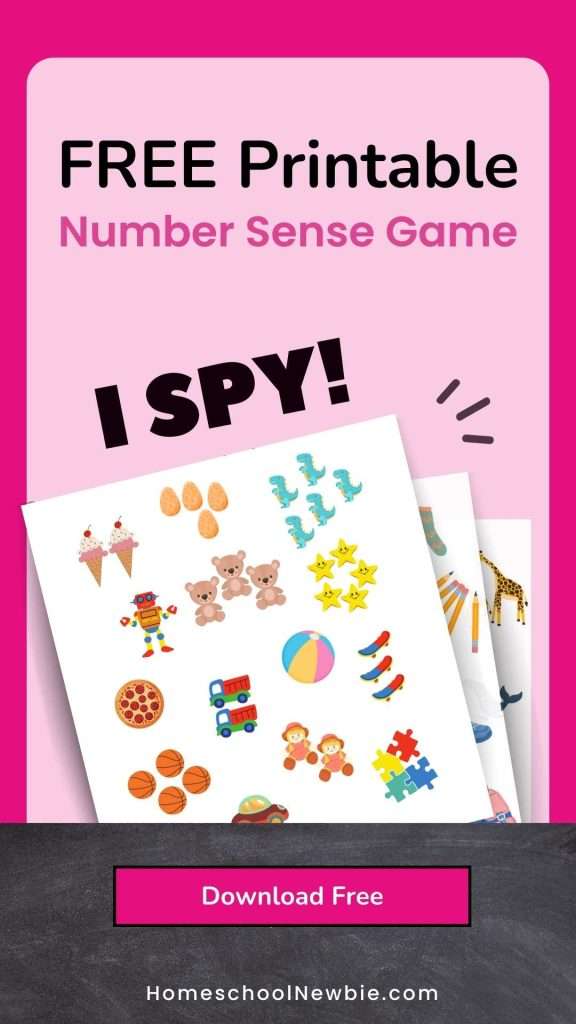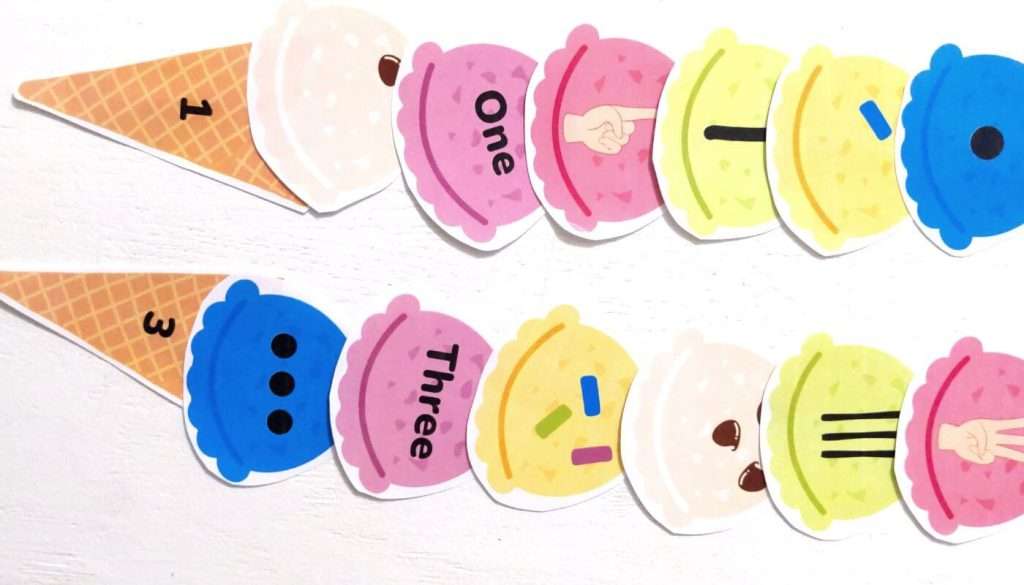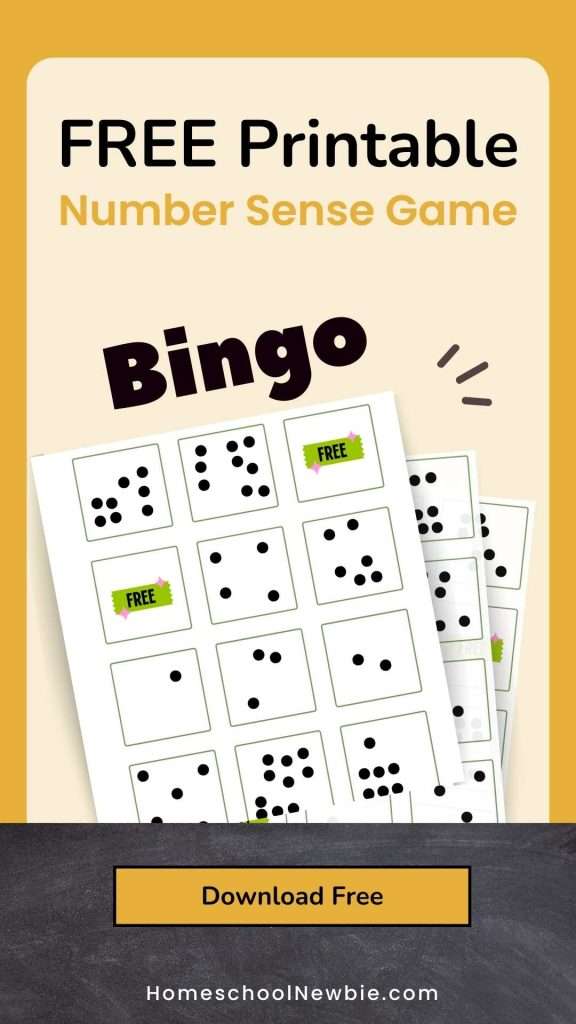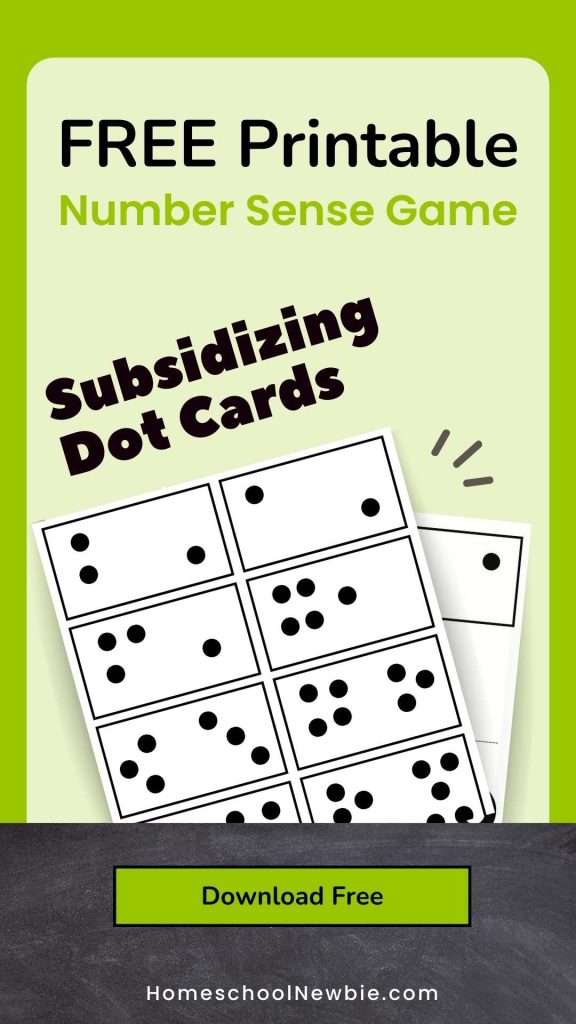I’ll be sharing 10 free number sense activities that your kids can do at home to start developing number sense. Whether you’re a student, a teacher, or a homeschool parent, these activities will help you and your children develop strong number sense.

Use these number sense activities to practice counting, recognizing numbers, subsidizing and understanding the relationships between numbers.
Best of all, they’re free! Grab your FREE number sense activities PDF here and let’s get started!
Use these activities to build number sense for…
- teaching number sense to struggling students as number sense interventions
- teaching number sense to preschoolers
- kindergarten math centers
- teaching number sense to first graders
- number sense activities at home
Do you want to learn more about improving number sense and number sense routines? Discover the answers in my post, where I explain what they are and how they can help you.
What is Number Sense & Why is It important?
Developing early number concepts and number sense skills are important for children to learn to understand how numbers relate to each other. It’s the ability to recognize patterns and use them to solve problems.
Math interventions for number sense help children understand concepts like counting, addition, subtraction, multiplication, fractions, ratios and more. It is a prerequisite step that every student must learn before moving onto any other math concept!
What Are The Benefits of Number Sense Activities?
Math number sense activities are designed to help children better understand numbers and how they relate to each other in fun and engaging ways.

Benefits of Developing Number Sense in Kindergarten:
- Developing number concepts builds understanding of counting, comparing, ordering, and grouping numbers.
- Understand basic operations such as addition and subtraction.
- Early number sense prepares for problem-solving and critical thinking skills.
- Basic number sense makes better readers and writers by learning relationships between numbers and words.
- Number sense and operations develop their ability to recognize patterns and spatial relationships.
Below is our list of the 10 free number sense examples to add to your number sense routines!
With these activities, your children will be able to master the basics of math sense and be ready to learn more complex concepts as they get older.
10 Free Number Sense Activities
1. I Spy
Get ready to test your number skills to see how many hidden numbers you can “spy”!

Objectives:
While playing, your children may count the objects individually but the goal is to eventually learn how to subitize or recognize the quantity without having to count the items separately.
- Counting
- Comparing
- Subitizing
Materials:
- Free I Spy Game Mat(s)
- Button or other small objects
- Optional: 6-Sided die
How To Play:
It’s played just like “I spy” but with a super fun number twist!
This game can be played individually or with a partner.

Version 1: Play With a Friend
To play with a partner, The first player takes a look at the I spy game printable and secretly selects a group of objects. The first player says, “I spy with my little eye something that has _____” then they add the quantity of that group of objects. For example, “I spy with my little eye something with 3”.
The second player then tries to guess the group of objects based on that clue and looking at the objects on the paper.
Player 2 can guess as many times as it takes and when they find the correct group of objects, they place a button on it.
Players take turns being the “spy” until all the objects are found.
Version 2: Play Alone
To play the game independently, all you need to do is add a die!
Roll the die and count the number on the die. Then find a group of objects on the picture that has the same number. Cover the group with a button, candy, or something else to indicate that that group has been rolled.
Repeat until all the groups have been found!
PSST… I made THREE versions of this “I spy” game to help keep this fresh for your kids. If you’d like to add them to your number sense routine, click here!
2. Ice Cream Number Match
A delicious math game to build a tower of ice cream scoops!

Objectives:
- Counting
- Identifying
- Comparing
- Recognizing relationships
Materials:
- Free Ice Cream Number Match Printable
How To Play:
This game can be played independently or with friends!
Version 1: Play Alone
To play independently, first shuffle the ice cream scoop number cards 1-5. If you are playing with very young students, you can limit the numbers to one or two numbers at a time.
Spread out the ice cream scoop numbers so your kids can view them.
Lay out the cones with the corresponding numbers leaving enough room to be able to stack the ice cream scoops on top.
Your child then chooses a number card and decides which cone it belongs to. Once your child has found the correct cone, your child stacks it on top. The game ends when all the ice cream scoops are placed.

Version 2: Play With Friends
You can also make this a multiplayer game with a few tweaks!
Shuffle the ice cream scoop number cards and stack them in a pile, face down in the center of the table. Each player gets an ice cream cone with a number on it and places it in front of them on the table.
When the players are ready to play, they turn over the center pile so everyone can see the top ice cream scoop card. The players then look at the center of the pile and the player with the matching number grabs the ice cream scoop card and adds it to their cone.
The players continue to grab the correct ice cream scoop cards until all of them are gone or the first player completes their ice cream cone stack first.
Version 3: Original Matching Game
You can also use this game to play traditional matching games. Just make sure to print the cards on thicker paper so the numbers are hidden when they are face down.
First, shuffle the cards and lay them out in rows face down. Players take turns flipping over two cards. If the cards represent the same number, the player keeps the match. If they do not match, they flip the card back over and the next player takes a turn.
Players play until all the cards are found.
3. Roll and Build
See if your kiddos can build a city of block towers using their counting skills!

Objectives:
- Identifying
- Comparing
- Recognizing relationships
Materials:
- Free Printable Roll & Build Mat
- Die
- Unifix cubes (or other small stacking items )
How To Play:
Version 1: Play Alone
First, roll a die and count the numbers on the die. Then build a tower using the Unifix cubes with the same number represented on the die. Find the number on the Build & Roll game mat and repeat until all the spaces on the mat are filled.
If your child rolls a number that already has a tower, roll again until they roll a number with an empty spot.

Version 2: Play With Friends
To play this game with friends, play the same as before except this time, have your kids take turns rolling the die.
If a player rolls a number that has already been placed, their turn is skipped.
Have the players choose a single color of Unifix cubes so they can easily see what towers they’ve placed. For example, player 1 builds red towers and player 2 builds blue towers.
When all the spaces are claimed, the players count how many towers they placed. The player with the most towers wins.
Special Tip: If your children have trouble linking the Unifix cubes together, you can pre-link them together and place them to the side of the game mat before they play.
4. Bingo
Whiz through this bingo game as your kids learn to recognize dot patterns by subsidizing!

Objectives:
- Identifying
- Counting
- Subsidizing
- Comparing
- Recognizing relationships
Materials:
- Free Number Sense Bingo Mats
- Small items such as buttons or candy
- Dice
How To Play:
This game can be played independently or with multiple players.

Version 1: Play With Friends
To play the game with multiple players, a player rolls the dice and the player counts and calls out the number. Each student tries to find the corresponding number on their bingo mat and places a marker over it.
If a player rolls an 11 or 12, they can either place a marker in the free spaces or just reroll the dice.
Players take turns rolling the dice. Each player marks their board until they get three or four in a row. You can also play until they get the spaces filled for blackout.
Version 2: Play Alone
To play independently, simply play the same as before except your child rolls the dice on their own.
5. Swat the Number
Race to be the first to swat those pesky number flies!

Objectives:
- Identifying
- Counting
- Subsidizing
- Comparing
- Recognizing relationships
Materials:
- Free Swat the Number Printable
- Fly swatter (or you can use your hand)
- Dice
How To Play:
This game can be played independently or with an opponent.

Version 1: Play Alone
To play the game independently, place 3-10 fly cards on a table so your child can see all of the cards.
Have your child roll the dice and swat the cards with the same number. They can use either a fly swatter or their hand.
If they get the correct card, they get to keep it. Play until all of the cards have been swatted.
Version 2: Play With A Friend
To play the game with an opponent, place 3-10 cards face up on a table.
Call out or roll a number with the dice. The players race to be the first to swat the correct fly with a fly swatter or their hands.
If they are first and correct, they get to keep the fly card.
Play until all of the cards are won and the player with the most wins.
6. What’s Different?
Test your counting and comparing skills. Can you spot the differences in the domino towers?

Objectives:
- Identifying
- Counting
- Subsidizing
- Comparing
- Recognizing relationships
Materials:
- Free printable What’s Different? game
- Unifix cubes
- Dominos
How To Play:
This game is best played independently but can be adapted to play with a partner.
To play, place a Domino in the center rectangle on the What’s Different sheet.
Build the number represented on each side of the Domino with building cubes.
Have your child compare the difference in the size of the two Unifix towers.
Invite discussion by asking questions such as “What is different about the amounts on the Domino?” or you can have them write down the difference independently.
Repeat until all of the spaces are completed on the What’s Different? sheet.
7. Count and Clap
Get your wiggles out with this active counting game!

Objectives:
- Identifying
- Counting
Materials:
- Free printable action die
- 1-2 six sided die
How To Play:
Prep: Cut out the die and fold along all the edges. Tape or glue the folding flaps to the sides until it forms a cube.
This game is played the same whether you are playing with friends or independently.

How To Play: Players roll the action die and a 6-sided die. If the dice lands on “jump” and the number 4, the players will jump 4 times. Repeat as many times as you want.
TIP: To make it more fun, you can play music and have the children do the actions to the music while playing.
I’ve also included more action dice in the Number Sense Games Extension pack for more fun ways to move and count.
8. Fill the Tin
Test your luck and counting skills – roll the die to see how fast you can fill up your muffin tin!

Objectives:
- Identifying
- Counting
- Comparing
- Recognizing relationships
Materials:
- Free printable Fill the Tin
- Small objects (buttons, erasers, or candy)
- Two 6-sided dice
How To Play:
Prep: Cut out the numbers and place the numbers in a muffin tin in order from 1-10. (Tape down if desired)
This game is played independently or with friends.

Version 1: Play independently
Player rolls one or two dice then finds the try with that number. Fill the tray with the number of objects rolled. If a player rolls a number that has already been filled, they reroll the dice. Play until all tins are full.
Version 2: Play With Friends
Players each roll dice to race to fill their muffin tins with the correct number of objects. The first player to correctly fill their muffin tin wins.
9. Subsidizing Cards
Race to be the first to spot patterns and uncover hidden numbers!

Objectives:
- Identifying
- Counting
- Subsidizing
- Comparing
- Recognizing relationships
Materials:
- Free printable subsidizing cards
How To Play:
How to Play: First, cut out the cards to play various games. There are many games for early number sense that you can play with subsidizing cards but today I’m going to share just three with you!

Number hunt: Hide the numbers around the room and try to find them. (You can challenge students by trying to find them in the right order.
Matching game: Print and cut out two copies of the cards. Flip the cards over then try to find the match.
Flash card race: Teacher flashes a card for two students to view. The first to say the correct number wins! If playing alone, see how many cards a student can say correctly in 30 seconds to 1 minute.
10. Cookie Ten Frame
Bake tasty counting skills as you fill your cookie sheets with numbers!

Objectives:
- Identifying
- Counting
- Subsidizing
- Comparing
- Recognizing relationships
Materials:
- Free printable Cookie Ten Frame activity
- Two 6-sided dice.
How To Play:
How to Play: Cut out the cookies and cookie sheet from the free printable linked in the description.

Version 1: Play alone
Roll one or two dice then fill the frames on the cookie sheet with that number of cookies. Repeat as many times as you’d like.
Version 2: Play with Friends
Print and cut out a copy of the Cookie Ten Frame game for each player. The players race to be the first to fill their cookie sheet with ten cookies by taking turns rolling the dice then filling in their cookie sheet with the same number of cookies. The first player to make it to ten cookies wins.
Wrap Up
These 10 FREE printable number sense activities are great tools for adding to your children’s number sense routines. With these activities, children can begin to build a strong understanding of number sense to prepare them for future math skills.

What’s Next?
Want More?? Get your number sense routine covered for your entire school year with the Number Sense Games Extension Pack!
Develop a strong foundation in number sense that will help your children succeed in their future math classes.
Check number sense off your list with this easy, done-for-you number sense activity extension pack!

Hi, I’m Courtney! I’m the founder of homeschoolnewbie.com. I’m a former elementary school teacher turned homeschool mama who has a passion for home education! I have 10+ years of experience working with children in all kinds of educational settings. As a new homeschooling parent, my mission is to navigate the world of homeschooling and share with you the best home education practices. If you want to learn more about me, check out my about page. See you there!

